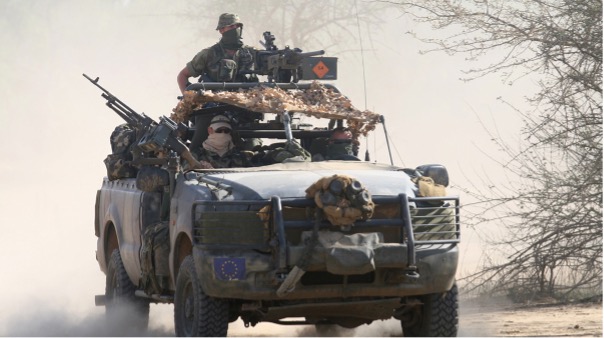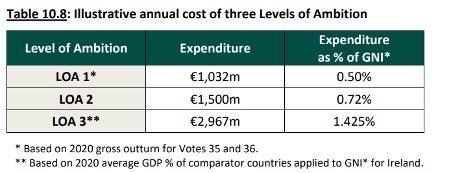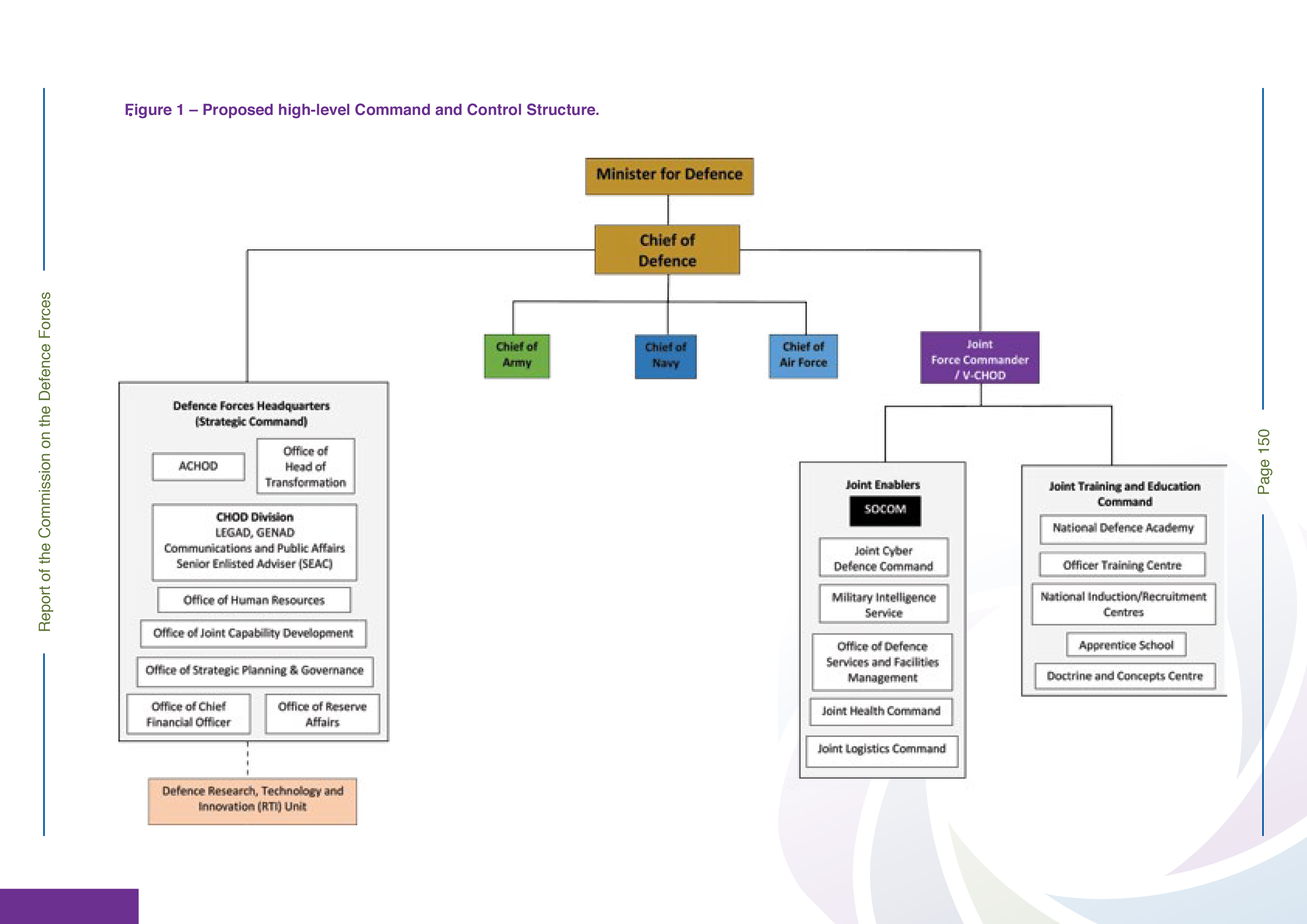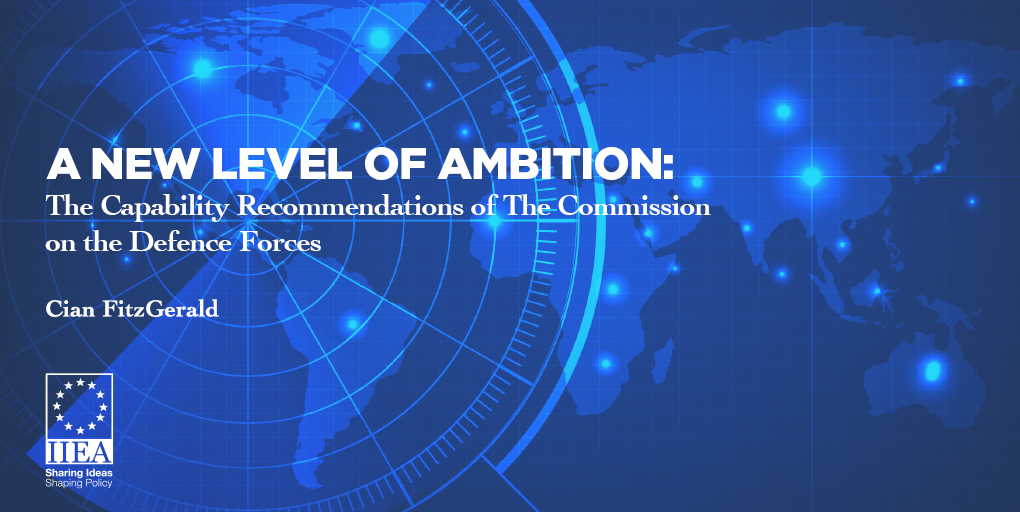A New Level of Ambition: The Capability Recommendations of The Commission on the Defence Forces
Author: Cian FitzGerald
Russia’s invasion of Ukraine is a turning point: an epochal event which, for many EU Member States, has engendered a moment of reflection on what it means to be territorially sovereign; on the dangers posed to national sovereignty; and what costs must be borne to defend it. Even before February 2022, however, the security environment had changed dramatically. The events following Russia’s 2014 annexation of the Crimean Peninsula initiated a proliferation of Gray Zone Warfare strategies ranging from information warfare, cyber campaigns and aggressive military exercises such as the one which took place off of the coast of Ireland’s Mizen Head in February 2022. Indeed, from climate change to cyber-attacks and nuclear proliferation, the range of threats which the world faces have become kaleidoscopic in nature. This has created a growing awareness in Europe about the dangers of taking sovereignty as a given, and that one must have the capabilities, the will, and the financial commitment to defend one’s sovereignty against potential aggressors.
Ireland’s Commission on the Defence Forces
Much like its European Member State counterparts, the Irish State has been reflecting on its geostrategic environment, and the condition of its own armed forces. On 15 December 2020, the Irish government tasked the Commission on the Defence Forces (CoDF) with sketching out a 2030 vision in which the Irish ‘Defence Forces will be a joint military force capable of providing the people of Ireland with a safe and secure environment and [of] enforcing Ireland’s sovereignty’ in an ‘evolving and complex world.[i] The Commission was comprised of members of the civil service, retired personnel from the Irish Defence Forces, as well as academics and advisors from Ireland and other European states of similar size, such as Finland. On 9 February 2022, with Russia preparing for its invasion of Ukraine, the Commission on the Defence Forces released its report.

Irish Forces during the UN MINURCAT mission in the Central African Republic and Chad[ii]
The Geostrategic Environment According to the Commission on the Defence Forces
The CoDF considers that Ireland’s global geostrategic environment will be ‘characterised by intensified great power competition.’[iii] While the threat of a direct combined arms attack against the Irish State is quite low, what has become more apparent is that there is now a ‘growing risk that Ireland’s land, air, maritime and cyber domains’ could become ‘vectors of attack’ towards Ireland’s neighbours and European partners.[iv] This has already occurred during the planned 3 February 2022 Russian naval exercise, which highlighted how Ireland was incapable of ensuring the safety of the undersea communications cables which connect Europe with North America. Ireland was singled-out and exposed as a weak-link in Western security architecture.
Capability and the Levels of Ambition.
The Commission divided its recommendations into three categories, entitled Levels of Ambition (LOAs). The objectives of these Levels of Ambitions are determined by the level of funding which would be allocated by the Oireachtas.
Level of Ambition One: Current Capability
This is the current state of the Defence Forces in terms of funding and ambition. In this LOA, the Defence Forces are aiming to uphold Ireland’s sovereign rights and to serve on peace support operations to the same extent as at present.[v] It would involve trying to maintain current capabilities, with routine modernisation of equipment and infrastructure, with the standing size of the force remaining at 13,569 personnel. In the Commission’s view, this would leave the Defence Forces unable to conduct a meaningful defence of the State against a sustained act of aggression from a conventional military force.[vi] This LOA requires a Defence Budget of €1.032 billion or 0.5% of Ireland’s Gross National Income.[vii]
Level of Ambition Two: Enhanced Capability
This would involve ‘building on current capability to address specific priority gaps in [the Defence Forces’] ability to deal with an assault on Irish sovereignty and to serve in higher intensity Peace Support Operations.’[viii] In the Commission’s view, to address such an assault on Irish sovereignty, the Defence Forces would require greater troop protection, firepower, and air and coastal defences. Moreover, Ireland’s situational awareness would have to be improved, requiring the purchasing of primary and coastal radar systems to maintain a Recognised Air Picture as well as a Recognised Maritime Picture, in essence an image of what is coming in and out of Irish waters and airspace. The Commission likewise recommends the creation of a Joint Cyber Defence Command. Finally, it recommends the revitalisation of the Reserve Defence Forces as part of a genuine single Defence Force. LOA2 would require a Defence Budget of €1.5 billion or 0.72% of Irelands Gross National Income.[ix]
Level of Ambition Three: Conventional Capability
To achieve its third LOA, the Commission recommends developing full spectrum defence capabilities to protect Ireland and its people to an extent comparable to similar sized countries in Europe. In other words, this would raise the capability level of the Defence Forces to that of its European peers. To reach LOA3, the Commission believes that the Army should have a substantial mechanised component, offering state of the art force protection, communications, and ISTAR (Intelligence, Surveillance, Target Acquisition and Reconnaissance). It would recommend that Ireland develop an air combat and intercept capability through the acquisition of a squadron of fast-jet combat aircraft. Finally, the Army Ranger Wing, which will be renamed in all levels of ambition to IRL SOF (Ireland Special Operations Force), would be given dedicated combat helicopter assets. LOA3 would require a Defence Budget of €2.967 billion or 1.425% of Ireland’s Gross National Income.[x]

The Command and Control (C2) Structure of the Irish Defence Forces
The Commission has recommended significant changes to the composition of the Defence Forces. One of the main priorities of the Department of Defence, and the Defence Forces, should be in constituting ‘parity of esteem’ among each of the individual branches of the Defence Forces. The Irish Defence Forces is, by and large, orientated towards operating in the land domain, yet as an island nation, the centrality of the maritime and air domains to national security are becoming increasingly apparent. Within the current C2 structure of the Defence Forces, the Army does not have a designated ‘head’ and the Air Corps and Naval Service are viewed as formations, and not as separate branches of the military.[xi] In the Commission’s view, this is not in line with best international practice.[xii] The Commission has recommended that the Naval Service and the Air Corps be renamed to the Irish Navy and to the Irish Air Force respectively,[xiii] and have made several recommendations for changes in the C2 structures of the Defence Forces. Amongst the most significant of these is the creation of the new roles of the Chief of the Army, Chief of the Navy, and Chief of the Air Force, overseen by the Chief of Defence, who will oversee the branches of the Army, Navy, and Air Force respectively.[xiv]

Implications
The Commission on the Defence Forces’ report has for the most part been received positively by Members of the Defence Forces itself and the Oireachtas. Though by no means surprising, the report has highlighted shortcomings and vulnerabilities that have long been observed by experts in the field, such as Ireland’s vulnerability to cyber-attacks.[xv] At present, Ireland spends €1.032 billion, or 0.3% of its GDP, on defence. Yet, the extent to which we may see the recommendations of the report implemented remains to be seen. Finland, one of Ireland’s closest defence partners, intends to spend 1.96% of its GDP on defence in 2022. Finland naturally has its own strategic culture and history resulting from it sharing a 1340km border with Russia. Minister for Defence Simon Coveney has indicated that spending may see an increase of €500 million per annum which would meet the LOA2 funding requirements.
By contrast to our Finnish counterparts, this would still only amount to 0.72% of our GNI. Though this would enhance the Defence Forces ability to serve in crisis management missions, were there to be an ‘assault on Irish sovereignty,’ for many a raison d’être of any armed forces, the Defence Forces could be without ‘the full-spectrum defence capabilities on a par with other sovereign European countries’[xvi] such as air-intercept, cyber and intelligence capabilities, necessary to defend the state. In such a scenario, the Defence Forces could still find themselves overmatched and limited in their ability to carry out their primary function of protecting the sovereignty of the Irish State.
With this in mind, an increase in spending of €500 million, though certainly a significant improvement on the present, will not allow for a more comprehensive expansion of the national security architecture. While there are currently no serious threats to Irish territorial sovereignty, the future is unknowable, and the deteriorating global security environment coupled with a more kaleidoscopic threat landscape mean that Ireland occupies a comparatively vulnerable position. To be able to address the full-spectrum of threats from cyber to conventional attack which it may face, it may ultimately be necessary for Ireland to emphasise its national security with a level of funding that reflects not only the clear and present dangers of the current threat landscape, but those which the Irish State may face in future too.
[i] Commission on the Defence Forces 2022: iii. Report of the Commission on the Defence Forces. Available at: https://www.gov.ie/en/publication/eb4c0-report-of-the-commission-on-defence-forces/
[ii] Irish Defence Forces. African Missions. Available at: https://www.military.ie/en/overseas-deployments/past-missions/african-missions/
[iii] Commission on the Defence Forces 2022: 5 Report of the Commission on the Defence Forces. Available at: https://www.gov.ie/en/publication/eb4c0-report-of-the-commission-on-defence-forces/
[iv] Commission on the Defence Forces 2022: 7 Report of the Commission on the Defence Forces. Available at: https://www.gov.ie/en/publication/eb4c0-report-of-the-commission-on-defence-forces/
[v] Commission on the Defence Forces 2022: iv Report of the Commission on the Defence Forces. Available at: https://www.gov.ie/en/publication/eb4c0-report-of-the-commission-on-defence-forces/
[vi] Commission on the Defence Forces 2022: iv Report of the Commission on the Defence Forces. Available at: https://www.gov.ie/en/publication/eb4c0-report-of-the-commission-on-defence-forces/
[vii] Commission on the Defence Forces 2022: 141 Report of the Commission on the Defence Forces. Available at: https://www.gov.ie/en/publication/eb4c0-report-of-the-commission-on-defence-forces/
[viii] Commission on the Defence Forces 2022: v Report of the Commission on the Defence Forces. Available at: https://www.gov.ie/en/publication/eb4c0-report-of-the-commission-on-defence-forces/
[ix] Ibid
[x] Ibid
[xi] Commission on the Defence Forces 2022: 57 Report of the Commission on the Defence Forces. Available at: https://www.gov.ie/en/publication/eb4c0-report-of-the-commission-on-defence-forces/
[xii] Commission on the Defence Forces 2022: 57 Report of the Commission on the Defence Forces. Available at: https://www.gov.ie/en/publication/eb4c0-report-of-the-commission-on-defence-forces/
[xiii] Commission on the Defence Forces 2022: 188. Report of the Commission on the Defence Forces. Available at: https://www.gov.ie/en/publication/eb4c0-report-of-the-commission-on-defence-forces/
[xiv] Commission on the Defence Forces 2022: 65 Report of the Commission on the Defence Forces. Available at: https://www.gov.ie/en/publication/eb4c0-report-of-the-commission-on-defence-forces/
[xv] Comdt Gavin Egerton 2019: 75 Multi-Domain Operations: The Need to Develop Resilience and Capability. Defence Forces Review 2019. Available at: https://www.military.ie/en/public-information/publications/defence-forces-review/df-review-2019.pdf
[xvi] Commission on the Defence Forces 2022: xii. Report of the Commission on the Defence Forces. Available at: https://www.gov.ie/en/publication/eb4c0-report-of-the-commission-on-defence-forces/

